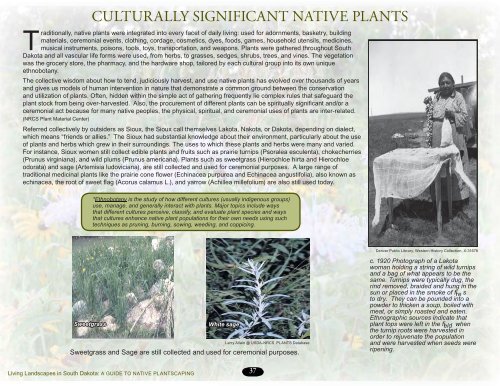Living Landscapes in South Dakota - Plant Materials Program - US ...
Living Landscapes in South Dakota - Plant Materials Program - US ...
Living Landscapes in South Dakota - Plant Materials Program - US ...
You also want an ePaper? Increase the reach of your titles
YUMPU automatically turns print PDFs into web optimized ePapers that Google loves.
CULTURALLY SIGNIFICANT NATIVE PLANTS<br />
Traditionally, native plants were <strong>in</strong>tegrated <strong>in</strong>to every facet of daily liv<strong>in</strong>g: used for adornments, basketry, build<strong>in</strong>g<br />
materials, ceremonial events, cloth<strong>in</strong>g, cordage, cosmetics, dyes, foods, games, household utensils, medic<strong>in</strong>es,<br />
musical <strong>in</strong>struments, poisons, tools, toys, transportation, and weapons. <strong>Plant</strong>s were gathered throughout <strong>South</strong><br />
<strong>Dakota</strong> and all vascular life forms were used, from herbs, to grasses, sedges, shrubs, trees, and v<strong>in</strong>es. The vegetation<br />
was the grocery store, the pharmacy, and the hardware shop, tailored by each cultural group <strong>in</strong>to its own unique<br />
ethnobotany.<br />
The collective wisdom about how to tend, judiciously harvest, and use native plants has evolved over thousands of years<br />
and gives us models of human <strong>in</strong>tervention <strong>in</strong> nature that demonstrate a common ground between the conservation<br />
and utilization of plants. Often, hidden with<strong>in</strong> the simple act of gather<strong>in</strong>g frequently lie complex rules that safeguard the<br />
plant stock from be<strong>in</strong>g over-harvested. Also, the procurement of different plants can be spiritually significant and/or a<br />
ceremonial act because for many native peoples, the physical, spiritual, and ceremonial uses of plants are <strong>in</strong>ter-related.<br />
(NRCS <strong>Plant</strong> Material Center)<br />
Referred collectively by outsiders as Sioux, the Sioux call themselves Lakota, Nakota, or <strong>Dakota</strong>, depend<strong>in</strong>g on dialect,<br />
which means “friends or allies.” The Sioux had substantial knowledge about their environment, particularly about the use<br />
of plants and herbs which grew <strong>in</strong> their surround<strong>in</strong>gs. The uses to which these plants and herbs were many and varied.<br />
For <strong>in</strong>stance, Sioux women still collect edible plants and fruits such as prairie turnips (Psoralea esculenta), chokecherries<br />
(Prunus virg<strong>in</strong>iana), and wild plums (Prunus americana). <strong>Plant</strong>s such as sweetgrass (Hierochloe hirta and Hierochloe<br />
odorata) and sage (Artemisia ludoviciana), are still collected and used for ceremonial purposes. A large range of<br />
traditional medic<strong>in</strong>al plants like the prairie cone flower (Ech<strong>in</strong>acea purpurea and Ech<strong>in</strong>acea angustifolia), also known as<br />
ech<strong>in</strong>acea, the root of sweet flag (Acorus calamus L.), and yarrow (Achillea millefolium) are also still used today.<br />
*Ethnobotany is the study of how different cultures (usually <strong>in</strong>digenous groups)<br />
use, manage, and generally <strong>in</strong>teract with plants. Major topics <strong>in</strong>clude ways<br />
that different cultures perceive, classify, and evaluate plant species and ways<br />
that cultures enhance native plant populations for their own needs us<strong>in</strong>g such<br />
techniques as prun<strong>in</strong>g, burn<strong>in</strong>g, sow<strong>in</strong>g, weed<strong>in</strong>g, and coppic<strong>in</strong>g.<br />
Denver Public Library, Western History Collection, X-31678<br />
Sweetgrass<br />
White sage<br />
Larry Alla<strong>in</strong> @ <strong>US</strong>DA-NRCS PLANTS Database<br />
Sweetgrass and Sage are still collected and used for ceremonial purposes.<br />
c. 1920 Photograph of a Lakota<br />
woman hold<strong>in</strong>g a str<strong>in</strong>g of wild turnips<br />
and a bag of what appears to be the<br />
same. Turnips were typically dug, the<br />
r<strong>in</strong>d removed, braided and hung <strong>in</strong> the<br />
sun or placed <strong>in</strong> the smoke of fi re s<br />
to dry. They can be pounded <strong>in</strong>to a<br />
powder to thicken a soup, boiled with<br />
meat, or simply roasted and eaten.<br />
Ethnographic sources <strong>in</strong>dicate that<br />
plant tops were left <strong>in</strong> the fi eld when<br />
the turnip roots were harvested <strong>in</strong><br />
order to rejuvenate the population<br />
and were harvested when seeds were<br />
ripen<strong>in</strong>g.<br />
<strong>Liv<strong>in</strong>g</strong> <strong>Landscapes</strong> <strong>in</strong> <strong>South</strong> <strong>Dakota</strong>: A GUIDE TO NATIVE PLANTSCAPING<br />
37

















